The Wireless Polysomnography Market is estimated to be valued at USD 218.8 billion in 2025 and is projected to reach USD 354.4 billion by 2035, registering a compound annual growth rate (CAGR) of 4.9% over the forecast period.
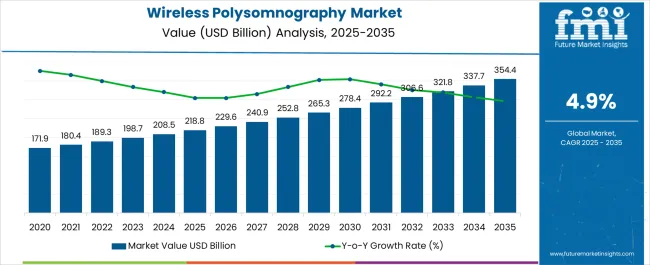
| Metric | Value |
|---|---|
| Wireless Polysomnography Market Estimated Value in (2025 E) | USD 218.8 billion |
| Wireless Polysomnography Market Forecast Value in (2035 F) | USD 354.4 billion |
| Forecast CAGR (2025 to 2035) | 4.9% |
The wireless polysomnography market is experiencing rapid growth driven by the increasing prevalence of sleep disorders, rising demand for home based monitoring, and advancements in wireless medical technologies. The need for accurate yet patient friendly diagnostic solutions has accelerated adoption of wireless PSG systems, which reduce discomfort while maintaining high diagnostic accuracy.
Healthcare providers are increasingly shifting toward ambulatory monitoring solutions to lower costs and improve patient convenience, while regulatory bodies emphasize early detection of sleep related conditions such as obstructive sleep apnea. Continuous innovation in signal processing, cloud connectivity, and integration with wearable sensors is enabling more reliable and scalable use of wireless PSG systems across clinical and remote settings.
The future outlook remains promising as healthcare systems prioritize preventive care, remote monitoring, and efficiency in diagnostic workflows.
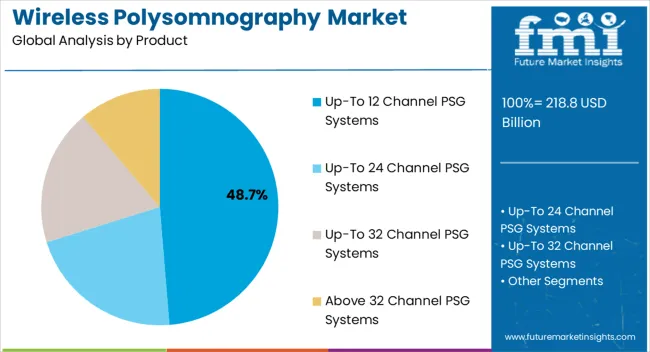
The up to 12 channel PSG systems segment is expected to account for 48.70% of total revenue by 2025 within the product category, making it the leading segment. Growth is being driven by the balance between affordability, portability, and sufficient diagnostic capability for common sleep disorders.
These systems are preferred in ambulatory and home based settings as they provide accurate results while minimizing complexity and patient discomfort. Healthcare providers value their efficiency in data collection and analysis, which supports widespread adoption.
This combination of convenience, cost effectiveness, and adequate diagnostic scope has strengthened the leadership of this product segment.
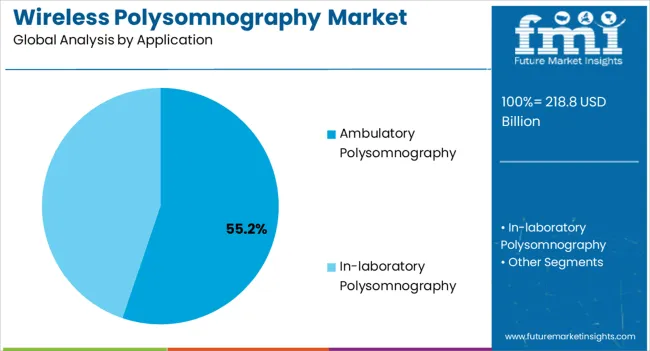
The ambulatory polysomnography segment is projected to contribute 55.20% of total revenue by 2025 within the application category, positioning it as the dominant segment. This growth is supported by increasing preference for home based diagnostics that enhance patient comfort and compliance while reducing hospitalization costs.
Ambulatory PSG allows real time monitoring in natural sleep environments, improving diagnostic accuracy for conditions that may be missed in clinical labs. The segment is also benefiting from advancements in compact wireless devices and cloud based data reporting, which streamline workflows for healthcare professionals.
These advantages have made ambulatory polysomnography the preferred application, reinforcing its market leadership.
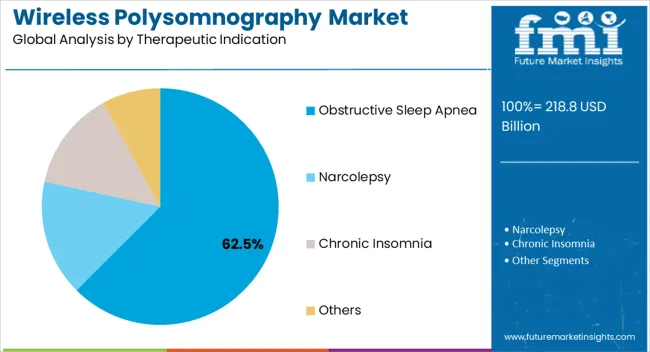
The obstructive sleep apnea segment is estimated to represent 62.50% of market revenue by 2025 within the therapeutic indication category, making it the most significant contributor. Growth is being propelled by the rising global burden of sleep apnea linked to obesity, aging populations, and lifestyle changes.
The need for early detection and long term management of the condition has accelerated adoption of wireless PSG systems in both clinical and ambulatory care. Insurance coverage expansions and growing awareness of the health risks associated with untreated sleep apnea have further reinforced segment growth.
This therapeutic area remains the cornerstone of demand for wireless polysomnography solutions due to its high prevalence and critical health implications.
From 2012 to 2025, the global wireless polysomnography market experienced a CAGR of 3.6%, reaching a market size of USD 218.8 million in 2025.
From 2012 to 2025, the global wireless polysomnography industry witnessed steady growth due to the greater mobility and ease of use. Polysomnography was mostly performed in sleep labs using wired equipment.
Wireless PSG systems were designed to provide a more convenient and comfortable option. Because of their greater mobility and ease of use, wireless PSG systems have grown in popularity. Adoption in sleep clinics and hospitals has increasing.
Wireless communication and sensor technology advancements have greatly expanded the possibilities of wireless PSG systems. As a result, data gathering, analysis, and patient comfort have all improved.
Future Forecast for Wireless Polysomnography Industry:
Looking ahead, the global wireless polysomnography industry is expected to rise at a CAGR of 5.2% from 2025 to 2035. During the forecast period, the market size is expected to reach USD 354.4 million by 2035.
The wireless polysomnography industry is expected to continue its growth trajectory from 2025 to 2035, driven by increasing prevalence of sleep apnea. Sleep disorders including sleep apnea and insomnia are growing increasingly common as a result of causes such as lifestyle changes, stress, and ageing populations. This trend is projected to boost future demand for wireless PSG systems.
Home-based sleep monitoring is becoming more popular as a way to improve patient comfort and convenience while lowering healthcare expenses. Wireless PSG devices are ideal for this application because they allow patients to complete sleep studies in the comfort of their own homes.
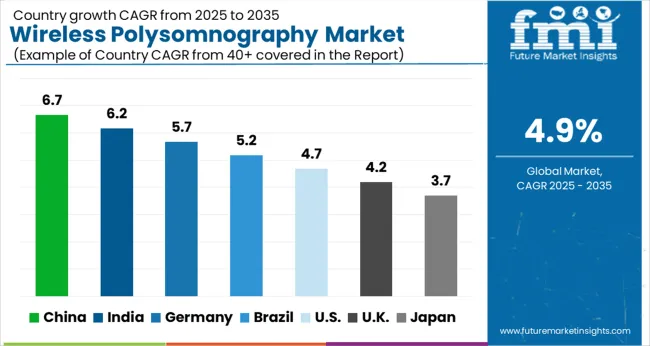
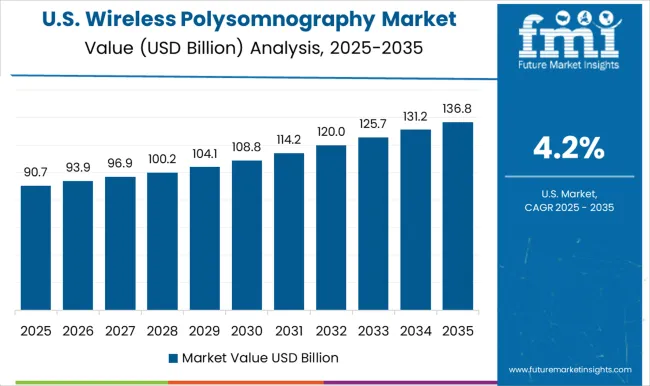
| Country | The United States |
|---|---|
| Market Size (USD million) by End of Forecast Period (2035) | USD 354.4 million |
| CAGR % 2025 to End of Forecast (2035) | 4.7% |
The wireless polysomnography industry in the United States is expected to reach a market size of USD 354.4 million by 2035, expanding at a CAGR of 4.7%. Wireless polysomnography is expected to see growth in the US market due to the increasing prevalence of sleep-related disorders.
The America Sleep Association estimates that between 50 and 208.5 million individuals in the USA have sleep apnea in 2024. In the United States, sleep problems are fairly common, thus a proper diagnosis is also quite important. As a result, the country is adopting wireless polysomnography equipment for medical diagnostics.
| Country | The United Kingdom |
|---|---|
| Market Size (USD million) by End of Forecast Period (2035) | USD 20.1 million |
| CAGR % 2025 to End of Forecast (2035) | 6.4% |
The wireless polysomnography industry in the United Kingdom is expected to reach a market value of USD 20.1 million, expanding at a CAGR of 6.4% during the forecast period. The United Kingdom market is projected to growth of the market due to the growing government initiatives and favorable policies.
The government of the United Kingdom has taken, or is preparing to take, a number of actions to combat obstructive sleep apnea cycle. In section 3.10, the government lists sleep apnea as an adult impairment. Such patients receive additional advantages, from education to therapy, removing any financial strain. The above-mentioned regulations all increased the need for wireless polysomnography.
| Country | China |
|---|---|
| Market Size (USD million) by End of Forecast Period (2035) | USD 21.1 million |
| CAGR % 2025 to End of Forecast (2035) | 6.0% |
The wireless polysomnography industry in China is anticipated to reach a market size of USD 21.1 million, moving at a CAGR of 6.0% during the forecast period. The wireless polysomnography industry in China is expected to grow prominently due to the increasing prevalence of sleep related disorders.
Obstructive sleep apnea and other sleep disorders are quite prevalent in China. According to the paper A narrative review of obstructive sleep apnea in China: A sleeping giant in disease pathology, in Heart Mind 2025, 218.8 million Chinese citizens suffer from obstructive sleep apnea. This rising prevalence contributes to the market growth for wireless polysomnography in the country.
| Country | Japan |
|---|---|
| Market Size (USD million) by End of Forecast Period (2035) | USD 15.2 million |
| CAGR % 2025 to End of Forecast (2035) | 5.7% |
The wireless polysomnography industry in Japan is estimated to reach a market size of USD 15.2 million by 2035, thriving at a CAGR of 5.7%. The market in Japan is predicted to grow because of the growing awareness and acceptance.
There is an increasing need for efficient treatment alternatives, such as polysomnography in the country as more individuals are becoming aware of the health dangers linked to disorders that cause sleep disorder issues. The elderly population in Japan is another significant market driver. The chance of developing sleep apnea rises with age, increasing the need for polysomnography.
| Country | South Korea |
|---|---|
| Market Size (USD million) by End of Forecast Period (2035) | USD 12.3 million |
| CAGR % 2025 to End of Forecast (2035) | 6.3% |
The wireless polysomnography industry in South Korea is expected to reach a market size of USD 12.3 million, expanding at a CAGR of 6.3% during the forecast period. In South Korea, sleeplessness is more common than earlier.
People who experience the symptoms of insomnia report a worsening of their quality of life in many areas and have a higher risk of developing other psychiatric illnesses. Thus, the rising incidence of insomnia is increasing people's knowledge of sleep problems, which is assisting the market's expansion.
The up-to 24 channel PSG systems is expected to dominate the wireless polysomnography industry with a CAGR of 4.4% from 2025 to 2035. Since there are more devices in the range of up to 24 channel PSG systems available than in the other product categories, this sector dominates the market for wireless polysomnography equipment.
The Ambulatory PSG segments are expected to dominate the wireless polysomnography industry with a CAGR of 5.6% from 2025 to 2035. This segment captures a significant market share in 2025.
Ambulatory PSG sleep tests are increasingly being used to diagnose sleep disorders. Ambulatory PSG allows to conduct of an overnight polysomnography assessment while the patient is still at home. These technologies provide sleep clinics with the flexibility of wireless and portable PSG systems by transporting sleep studies from the sleep clinic to the patient's home.
The Obstructive sleep apnea (OSA) segments is expected to dominate the wireless polysomnography industry with a CAGR of 4.7% from 2025 to 2035. As the occurrences of obstructive sleep apnea are increasing in comparison to the other sectors, this category is going to hold a considerable market share in 2025.
Polysomnography captures and classifies sleep phases, as well as the occurrence and duration of apneic and hypopneic episodes. It is useful for verifying OSA diagnosis and assessing OSA severity.
The sleep laboratories segment is expected to dominate the wireless polysomnography industry with a CAGR of 4.7% from 2025 to 2035. The increasing number of clinics sleep clinics or laboratories in the field of sleep medicine is a key factor due to which the sleep laboratories have been estimated to account for more than half of the share of the end user segment in the forecast period as well.

The wireless polysomnography sector is fiercely competitive, with many companies fighting for market dominance. To stay ahead of the competition in such a circumstance, essential players must employ smart techniques.
Key Strategies Used by the Participants
Product Innovation
Key players focus on developing and introducing innovative products to address unmet needs in the market. They invest in research and development to improve existing formulations, delivery systems, and enhance the efficacy and safety of the products
Strategic Partnerships and Collaborations
Key players often form strategic partnerships and collaborations with other companies, research institutes, or healthcare organizations, these partnerships allow for knowledge sharing, joint research and development efforts, and access to complementary technologies or expertise.
Expansion into Emerging Markets
Key players strive to expand their presence in different geographic regions to tap into new markets and reach a wider customer base. They may establish subsidiaries, distribution networks or strategic alliances in various countries to strengthen their market position.
Mergers and Acquisitions
Companies in the market may engage in mergers or acquisitions to consolidate their product portfolio, acquire new technologies, these strategic moves allow companies to enter new market segments, gain access to novel products or intellectual property, and achieve synergies in terms of research, manufacturing, or distributions.
Key Developments in the Wireless Polysomnography Market:
The global wireless polysomnography market is estimated to be valued at USD 218.8 billion in 2025.
The market size for the wireless polysomnography market is projected to reach USD 354.4 billion by 2035.
The wireless polysomnography market is expected to grow at a 4.9% CAGR between 2025 and 2035.
The key product types in wireless polysomnography market are up-to 12 channel psg systems, up-to 24 channel psg systems, up-to 32 channel psg systems and above 32 channel psg systems.
In terms of application, ambulatory polysomnography segment to command 55.2% share in the wireless polysomnography market in 2025.






Full Research Suite comprises of:
Market outlook & trends analysis
Interviews & case studies
Strategic recommendations
Vendor profiles & capabilities analysis
5-year forecasts
8 regions and 60+ country-level data splits
Market segment data splits
12 months of continuous data updates
DELIVERED AS:
PDF EXCEL ONLINE
Wireless Access Point Market Size and Share Forecast Outlook 2025 to 2035
Wireless Video - 2.4/5GHz Market Size and Share Forecast Outlook 2025 to 2035
Wireless Audio Devices Market Size and Share Forecast Outlook 2025 to 2035
Wireless Communication Technologies In Healthcare Market Size and Share Forecast Outlook 2025 to 2035
Wireless Mesh Network Market Size and Share Forecast Outlook 2025 to 2035
Wireless Sensor Tags Market Size and Share Forecast Outlook 2025 to 2035
Wireless Sensor Network Market Size and Share Forecast Outlook 2025 to 2035
Wireless Power Transmission Market Size and Share Forecast Outlook 2025 to 2035
Wireless Home Security Camera Market Size and Share Forecast Outlook 2025 to 2035
Wireless Testing Market Size and Share Forecast Outlook 2025 to 2035
Wireless Power Bank Market Size and Share Forecast Outlook 2025 to 2035
Wireless Battery Monitoring System Market Size and Share Forecast Outlook 2025 to 2035
Wireless Printer Market Size and Share Forecast Outlook 2025 to 2035
Wireless Headphones Market Size and Share Forecast Outlook 2025 to 2035
Wireless Sensors Market Size and Share Forecast Outlook 2025 to 2035
Wireless Display Market Size and Share Forecast Outlook 2025 to 2035
Wireless Paging Systems Market Size and Share Forecast Outlook 2025 to 2035
Wireless Patient Monitoring Market Size and Share Forecast Outlook 2025 to 2035
Wireless Earphone Market Size and Share Forecast Outlook 2025 to 2035
Wireless Ev Charging Market Size and Share Forecast Outlook 2025 to 2035

Thank you!
You will receive an email from our Business Development Manager. Please be sure to check your SPAM/JUNK folder too.
Chat With
MaRIA